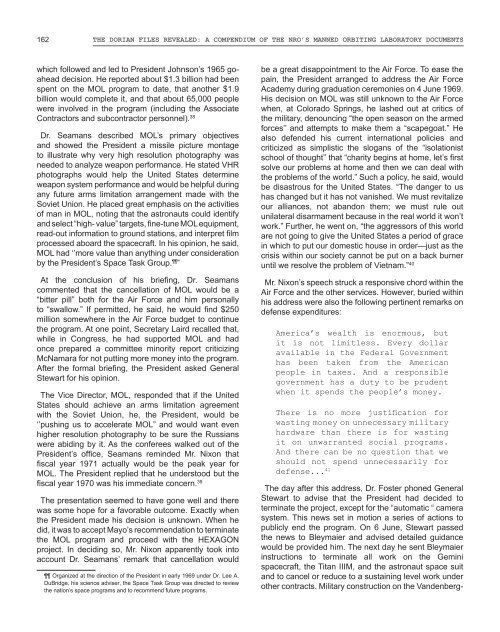NRO-MOL_2015
You also want an ePaper? Increase the reach of your titles
YUMPU automatically turns print PDFs into web optimized ePapers that Google loves.
162 The Dorian Files Revealed: a Compendium of the <strong>NRO</strong>’s Manned Orbiting Laboratory Documents<br />
which followed and led to President Johnson’s 1965 goahead<br />
decision. He reported about $1.3 billion had been<br />
spent on the <strong>MOL</strong> program to date, that another $1.9<br />
billion would complete it, and that about 65,000 people<br />
were involved in the program (including the Associate<br />
Contractors and subcontractor personnel). 38<br />
Dr. Seamans described <strong>MOL</strong>’s primary objectives<br />
and showed the President a missile picture montage<br />
to illustrate why very high resolution photography was<br />
needed to analyze weapon performance. He stated VHR<br />
photographs would help the United States determine<br />
weapon system performance and would be helpful during<br />
any future arms limitation arrangement made with the<br />
Soviet Union. He placed great emphasis on the activities<br />
of man in <strong>MOL</strong>, noting that the astronauts could identify<br />
and select “high- value” targets, fine-tune <strong>MOL</strong> equipment,<br />
read-out information to ground stations, and interpret film<br />
processed aboard the spacecraft. In his opinion, he said,<br />
<strong>MOL</strong> had ‘’more value than anything under consideration<br />
by the President’s Space Task Group. ”<br />
At the conclusion of his briefing, Dr. Seamans<br />
commented that the cancellation of <strong>MOL</strong> would be a<br />
“bitter pill” both for the Air Force and him personally<br />
to “swallow.” If permitted, he said, he would find $250<br />
million somewhere in the Air Force budget to continue<br />
the program. At one point, Secretary Laird recalled that,<br />
while in Congress, he had supported <strong>MOL</strong> and had<br />
once prepared a committee minority report criticizing<br />
McNamara for not putting more money into the program.<br />
After the formal briefing, the President asked General<br />
Stewart for his opinion.<br />
The Vice Director, <strong>MOL</strong>, responded that if the United<br />
States should achieve an arms limitation agreement<br />
with the Soviet Union, he, the President, would be<br />
‘’pushing us to accelerate <strong>MOL</strong>” and would want even<br />
higher resolution photography to be sure the Russians<br />
were abiding by it. As the conferees walked out of the<br />
President’s office, Seamans reminded Mr. Nixon that<br />
fiscal year 1971 actually would be the peak year for<br />
<strong>MOL</strong>. The President replied that he understood but the<br />
fiscal year 1970 was his immediate concern. 39<br />
The presentation seemed to have gone well and there<br />
was some hope for a favorable outcome. Exactly when<br />
the President made his decision is unknown. When he<br />
did, it was to accept Mayo’s recommendation to terminate<br />
the <strong>MOL</strong> program and proceed with the HEXAGON<br />
project. In deciding so, Mr. Nixon apparently took into<br />
account Dr. Seamans’ remark that cancellation would<br />
Organized at the direction of the President in early 1969 under Dr. Lee A.<br />
DuBridge, his science adviser, the Space Task Group was directed to review<br />
the nation’s space programs and to recommend future programs.<br />
be a great disappointment to the Air Force. To ease the<br />
pain, the President arranged to address the Air Force<br />
Academy during graduation ceremonies on 4 June 1969.<br />
His decision on <strong>MOL</strong> was still unknown to the Air Force<br />
when, at Colorado Springs, he lashed out at critics of<br />
the military, denouncing “the open season on the armed<br />
forces’’ and attempts to make them a “scapegoat.” He<br />
also defended his current international policies and<br />
criticized as simplistic the slogans of the “isolationist<br />
school of thought’’ that “charity begins at home, let’s first<br />
solve our problems at home and then we can deal with<br />
the problems of the world.” Such a policy, he said, would<br />
be disastrous for the United States. “The danger to us<br />
has changed but it has not vanished. We must revitalize<br />
our alliances, not abandon them; we must rule out<br />
unilateral disarmament because in the real world it won’t<br />
work.” Further, he went on, “the aggressors of this world<br />
are not going to give the United States a period of grace<br />
in which to put our domestic house in order—just as the<br />
crisis within our society cannot be put on a back burner<br />
until we resolve the problem of Vietnam.” 40<br />
Mr. Nixon’s speech struck a responsive chord within the<br />
Air Force and the other services. However, buried within<br />
his address were also the following pertinent remarks on<br />
defense expenditures:<br />
America’s wealth is enormous, but<br />
it is not limitless. Every dollar<br />
available in the Federal Government<br />
has been taken from the American<br />
people in taxes. And a responsible<br />
government has a duty to be prudent<br />
when it spends the people’s money.<br />
There is no more justification for<br />
wasting money on unnecessary military<br />
hardware than there is for wasting<br />
it on unwarranted social programs.<br />
And there can be no question that we<br />
should not spend unnecessarily for<br />
defense... 41<br />
The day after this address, Dr. Foster phoned General<br />
Stewart to advise that the President had decided to<br />
terminate the project, except for the “automatic “ camera<br />
system. This news set in motion a series of actions to<br />
publicly end the program. On 6 June, Stewart passed<br />
the news to Bleymaier and advised detailed guidance<br />
would be provided him. The next day he sent Bleymaier<br />
instructions to terminate all work on the Gemini<br />
spacecraft, the Titan IIIM, and the astronaut space suit<br />
and to cancel or reduce to a sustaining level work under<br />
other contracts. Military construction on the Vandenberg-

















